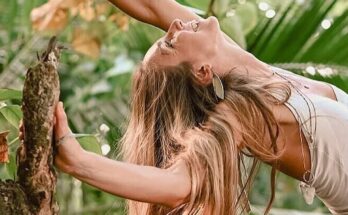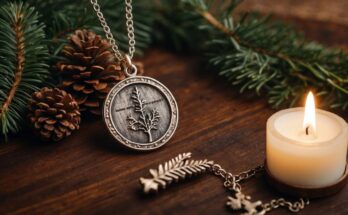Rudraksha Mala is a string of prayer beads made from Rudraksha tree seeds that is usually worn during chanting and meditation practice to keep one focused, steady, and calm during spiritual practice.
People still wear Rudraksha Mala today due to its grounding effect, cultural value, and connection to tradition.
Discover what sets this bead apart, how it fits into daily rituals, why some swear by its effect, and its relevance in modern society.
The Meaning Behind the Name
“Rudraksha” refers to “the eye of Rudra,” which refers to Lord Shiva.
According to the old texts, it is believed that the Rudraksha tree grew out of Shiva’s tears after the Lord opened his eyes following an intense contemplation.
The name itself links the bead with focus, stillness, and presence.
Where Do Rudraksha Beads Come From?
The seeds are cultivated on broad-leafed, tall trees that are found throughout Nepal, India, and some parts of Indonesia.
The most well-known and finest beads come from Nepal because of their size and texture. Farmers collect seeds when they fall, wash them, and allow them to dry.
Basic Structure of the Mala (108 Beads + 1 Guru Bead)

A standard Rudraksha Mala has 108 beads and one larger bead called the guru bead.
This number isn’t random—it’s tied to ancient counting systems used in prayer. You start and end your mantra repetition without crossing over the guru bead, out of respect.
Religious and Cultural Significance
Within Hinduism, Rudraksha is linked to Shiva and is worn by those seeking clarity of mind or spiritual peace. In Buddhism and a few yoga traditions,
It’s often used to recite mantras. Although its roots are in the religion of God, it is used by people of many different paths to use it for concentration or stress relief. It’s also used for routine.
How a Rudraksha Mala Works?
The following is how Rudraksha works.
Physical Properties of the Seed
It is believed that the Rudraksha seed is a rough one and adorned with natural lines known as mukhis.
These physical characteristics provide it with a distinct form and texture that is believed to affect wearers’ energy.
The beads feel solid yet light, which makes them comfortable to wear for meditation or during prayer.
How the Bead Interacts with the Body
When you wear or use a Rudraksha Mala, the beads touch your skin and are thought to help balance your body’s energy.
People say this helps calm the mind and reduce stress. While not everyone feels it, many find the beads offer a steady presence during quiet moments.
Common Practices and Rituals
Common rituals include cleaning the mala regularly and chanting specific mantras while holding each bead.
These practices create a rhythm, helping focus the mind and strengthen the connection between wearer and bead.
Use in Mantra Chanting (Japa)
Mantra chanting, or japa, is the main use of a Rudraksha Mala. You move your fingers bead by bead, repeating a prayer or mantra silently or aloud. This repetition can ground your thoughts and bring a sense of calm.
Why People Still Wear Rudraksha Malas

Mental Focus and Stress Relief
Many wear Rudraksha Malas to sharpen mental focus and ease daily stress. The beads offer a simple tool to keep attention steady when life gets busy. Holding or wearing the beads can feel like a small anchor.
Daily Spiritual Practice and Intention
For some, the mala is part of a daily spiritual routine, reminding them to stay mindful and intentional.
It’s a quiet signal to pause, breathe, and reset. This habit can bring calm to otherwise hectic days.
Traditional Beliefs About Protection
Traditional beliefs hold that Rudraksha beads protect the wearer from harm and negative energy.
This is why many wear them even outside of formal prayer, trusting the beads to guard their well-being.
Reasons It’s Popular Beyond Religion (Wellness, Yoga, Simplicity)
Beyond religion, Rudraksha Malas are popular in yoga and wellness circles. Their simplicity and natural feel appeal to those looking for tools that support calmness without complication.
You’ll find out why people value Rudraksha Malas today, from stress relief to spiritual practice and simple protection.
Types of Rudraksha Beads and Their Uses
Mukhi Explained (1 to 21)
Rudraksha beads are classified by the number of lines or faces on them, called mukhis, which range from 1 to 21.
Each mukhi is said to have different effects or meanings, influencing the choice of mala.
Most Common Types and Who They’re For
The most common is the 5 Mukhi Rudraksha, worn by many for general health and calm.
Other types, like the 1 or 7 Mukhi, are sought for specific purposes like focus or prosperity. The right bead depends on personal needs or beliefs.
What to Watch Out For (Fake vs Genuine)
Watch out for fake beads that look too perfect or are made from plastic. Genuine Rudraksha seeds have natural imperfections and a rough texture.
Buying from trusted sellers helps avoid fraud.
You’ll learn about mukhis, which ones are common, and how to spot genuine beads and their connection to spiritual Japanese art.
How to Choose and Wear a Rudraksha Mala
Sizing and Bead Count
Choosing the right size and bead count depends on your purpose and comfort. Most malas have 108 beads plus one guru bead.
If you want a wrist mala, smaller beads work better; for neck malas, larger beads are better suited.
Neck vs Wrist Malas
Neck malas are worn as spiritual jewelry, while wrist malas are handy for meditation. You can pick what fits your lifestyle and routine best.
Do’s and Don’ts of Wearing
Do’s include treating the mala respectfully and keeping it clean. Don’t wear it while bathing or sleeping for some people. Avoid letting others touch your mala to keep its energy personal.
How to Cleanse and Energise It
To purify, take the mala and soak it in milk or water, and then dry it in sunlight. The practice of chanting regularly or keeping the beads can also charge their power.
Get clear advice about choosing the correct mala, the best way to properly wear it, and the best way to care for it.
Where to Buy an Authentic Rudraksha Mala
Trusted Sources to Consider
The most reliable place to purchase genuine Rudraksha malas is to purchase from reliable sellers from Nepal, India, and Indonesia.
Indonesia, particularly, is renowned for its authentic Rudraksha beads because of its nature-based expansion from Rudraksha trees. Buying locally can mean more authentic and higher quality.
What Certification Looks Like
A genuine Rudraksha mala usually comes with a certificate of authenticity from a trusted authority or seller.
This certificate verifies the seed’s origin, mukhi count, and natural quality. Look for sellers who provide clear photos and documentation.
Red Flags in the Market
Be cautious if beads look overly perfect, too cheap, or come without any proof of authenticity.
Fake or synthetic malas are common online. Avoid sellers who can’t provide detailed information or certifications.




